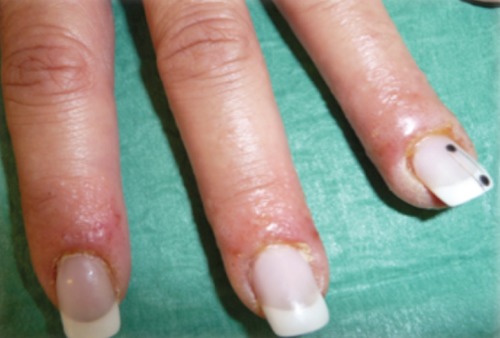Abstract
Methylmethacrylate was first reported in 1941 as a cause of contact dermatitis. Since then, occupational contact allergies to acrylates in dentistry, orthopedic surgery, printing industry and industry have been reported, but few reports are found in the literature as a consequence of the contact with sculptured artificial acrylic nails which are increasingly popular. We describe here 3 patients with contact allergy to acrylates in artificial sculptured nails. Patch tests were performed with the Portuguese baseline series of contact allergens and an extended series of acrylates were applied. In particular, we tested three female patients with allergic contact dermatitis from sculptured acrylic nails. Two of these patients were both customers and also technical nail beauticians. Two patients developed periungual eczema; one presented only with face and eyelid dermatitis had no other lesions. The tests showed positive reaction to 2-hydroxyethylmethacrylate (2-HEMA) and 2-hydroxypropylmethacrylate (2-HPMA) in all the three patients. Our cases demonstrate the variety of clinical presentations of allergic contact dermatitis from acrylic sculptured nails. They show the need to warn patients of persistent and sometimes permanent side effects of these products. They also emphasize the importance of cosmetic ingredient labeling.
Key words: contact allergy dermatitis, acrylates, airborne dermatitis.
Introduction
Sculptured artificial acrylic nails, have gained popularity over recent years. They can cause allergic contact dermatitis both in occupational and non-occupational settings. Acrylates are known allergens and also irritants.1 Methylmethacrylate was the first reported in 1941 as a cause of contact dermatitis.2 Since then, occupational contact allergies to acrylates in dentistry, orthopedic surgery, printing industry and industry have been reported in the literature.3,4
Polymerization of acrylate occurs when the polymer and the monomer are mixed together in the presence of an organic peroxide catalyst and accelerator. Hardening occurs at room temperature. However with photobonded sculptured acrylate nails, polymerization requires exposure to UV radiation.4 In this study, we describe 3 patients with distinct clinical presentations of contact allergy to acrylates present in artificial nails. The patients were observed in a Contact Dermatitis Unit.
Case Report
Epicutaneous tests were applied on the upper back using Finn Chambers®, and a positive patch test reaction was defined according to the International Contact Dermatitis Research Group guidelines. All patients were tested with the European baseline series (with additions recommended by the Portuguese Contact Dermatitis Study Group) and personal products. An extended series of acrylates were applied.
Results
We observed three female patients aged 35–50 years old (mean 41.5) with allergic contact dermatitis from sculptured acrylic nails. Two of these patients were both customers and also professional nail beauticians. Two patients (one customer and the other both customer and professional nail beautician) developed periungual eczema two and four months respectively after the first application of acrylic gel (Figure 1); one of them had clinically an airborne pattern. The third patient only presented with dermatitis localized to the face and eyelid that was noted four months after the first contact with sculptured acrylic nails. This patient had no hand/periungual or any other cutaneous lesions at distant sites. The tests showed positive reactions to 2-hydroxyethylmethacrylate (2-HEMA) and 2-hydroxypropylmethacrylate (2-HPMA) in three patients.
Figure 1.

Clinical aspect of periungueal dermatitis.
Positive reactions to other acrylates were also found: in all our patients 2-hydroxypropyl methacrylate and triethylene glycol diacrylate; two of our patients tested positive for 2-hydroxyethyl methacrylate, ethylacrylate and hydroxyethyl acrylate, showing how allergic sensitization induced by one acrylic compound extends to one or more other acrylic compounds. One patient tested also positive to nickel with probable relevance to jewelry and to metallic pigment nail polisher.
Dermatitis resolved in all patients after having their acrylic gel nails removed and in those with occupational setting, after they stop working with as manicurists.
Discussion
Nowadays are available three distinct types of sculptured acrylic nails: acrylate monomers and polymers that polymerize at room temperature in the presence of an organic peroxide and accelerator; photobonded sculptured acrylate nails in which polymerization of the acrylate requires exposure to UV radiation; and, cyanoacrylates nail preparations. Our cases only used sculptured acrylic nails. Initial formulations contained methyl methacrylate monomer, which caused severe contact dermatitis, paronychia and nail dystrophy. Since 1974, the Food and Drug Administration banned the use of this monomer in artificial nails.6 Currently marketed artificial nails contain various methacrylate ester monomers such as ethyl, butyl and isobutyl methacrylate monomers; dimethacrylates and trimethacrylates.
Conclusions
The reported cases demonstrate the heterogeneous clinical presentation of allergic contact dermatitis from sculptured acrylic nails. Clinical manifestation in sensitized patients includes: contact dermatitis at contact areas and at sites distant to the contact; transient or permanent nail dystrophies and paronychia.6,7 Eyelid and face dermatitis can be caused by airborne dusts of completely polymerized resins that have become depolymerized by the filing process or by exposure to organic vapors and polymethacrylate dusts.
The particular clinical presentation with an airborne pattern following exposure to methacrylate ester monomers has been reported in the English literature in dentistry, orthopedic surgery and printing industry but never in patients with sculptured artificial acrylic nails thus far as we know.
References
- 1.Lazarov A. Sensitization to acrylates is a common adverse reaction to artificial fingernails. J Eur Acad Dermatol Venereol. 2007;21:169–74. doi: 10.1111/j.1468-3083.2006.01883.x. [DOI] [PubMed] [Google Scholar]
- 2.Stevenson WJ. Methyl methacrylate dermatitis. Contact Point. 1941;18:171. [Google Scholar]
- 3.Farli M, Gasperini M, Francalanci S, et al. Occupational contact dermatitis in 2 dental technicians. Contact Dermatitis. 1990;22:282–7. doi: 10.1111/j.1600-0536.1990.tb01597.x. [DOI] [PubMed] [Google Scholar]
- 4.Hemmer W, Focke M, Jarish R. Allergic contact dermatitis to artificial fingernails prepared from UV light-cured acrylates. J Am Acad Dermatol. 1996;35:377–80. doi: 10.1016/s0190-9622(96)90600-3. [DOI] [PubMed] [Google Scholar]
- 5.Constandnt L, Hecke EV, Naeyaert JM, Goosens A. Screening for contat allergy to artificial nails. Contact Dermatitis. 2005;52:73–7. doi: 10.1111/j.0105-1873.2005.00496.x. [DOI] [PubMed] [Google Scholar]
- 6.Fisher A. Adverse nail reactions and paraesthesia from photobonded acrylate sculptured acrylic nails. Cutis. 1990;45:293–4. [PubMed] [Google Scholar]
- 7.Andersen SL, Rastogi SC, Andersen KE. Occupational allergic contact dermatitis to hydroxyethyl methacrylate (2-HEMA) in a manicurist. Contact Dermatitis. 2009;61:48–50. doi: 10.1111/j.1600-0536.2009.01546.x. [DOI] [PubMed] [Google Scholar]


